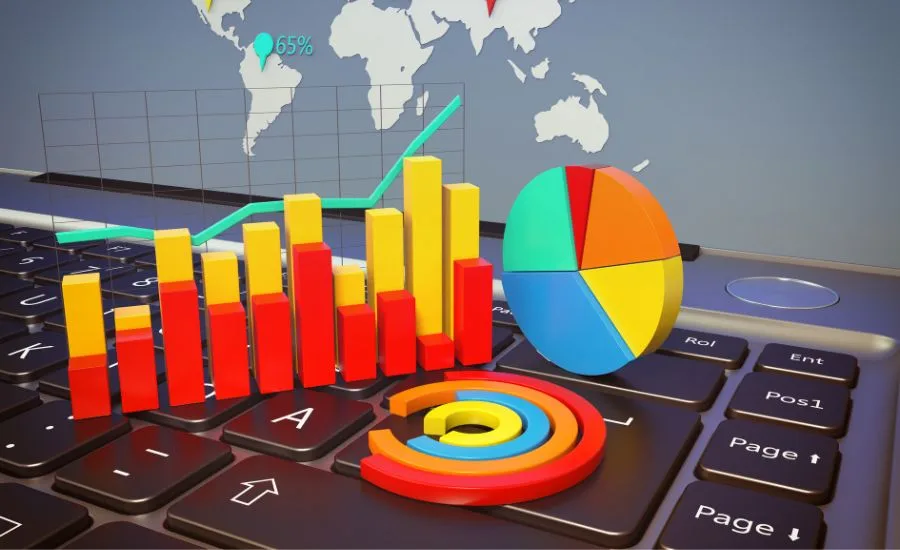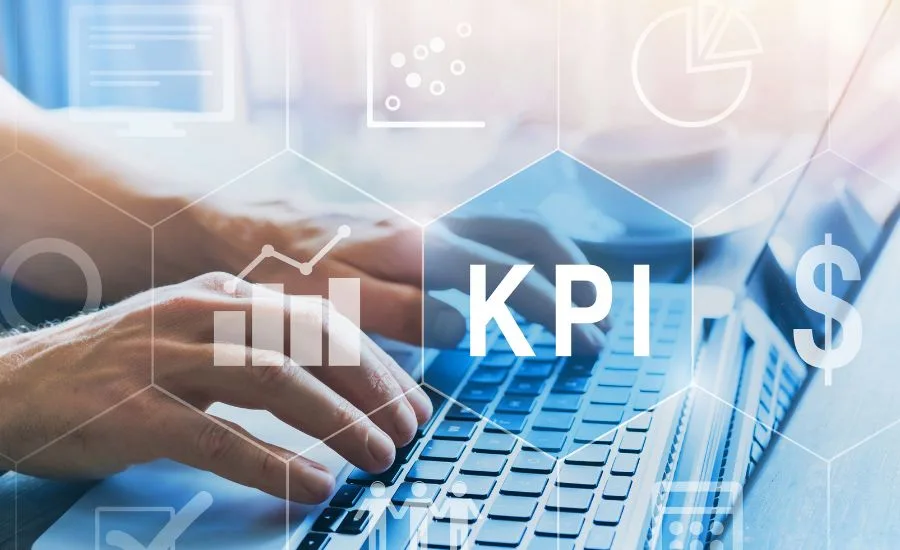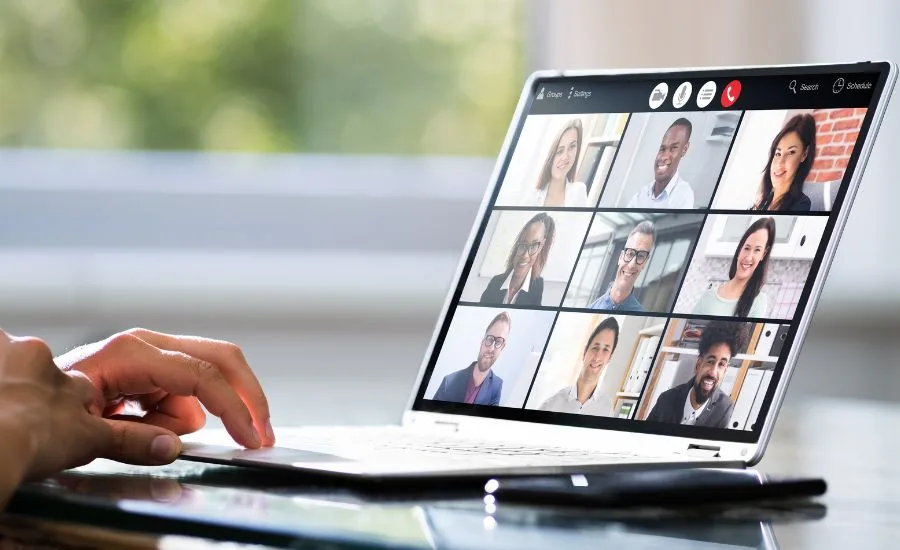Conducting webinars can be a great marketing strategy to make your sales funnel more effective and push your target audience toward the bottom of the funnel. Webinars benefit you with a group of strategies to advertise products and services, raise brand awareness, and educate your audience.
Hosting webinars enables brands to demonstrate their subject-matter expertise and cultivate leads.
A whopping 89% of marketers agreed that the best platform for growing their businesses is organizing webinars. Given that 61% of webinars are hosted by B2B businesses, it must be acknowledged that hosting webinars is primarily a B2B marketing technique. They are increasingly important in B2B sales funnels. (source: influno.com)
With the increasing popularity of webinars as a strategy for marketing, it has become challenging for businesses to increase attendance and further boost conversions through webinars.
However, if you have the right approach, webinars can successfully benefit you. So, let’s dive deep into understanding this time-tested and powerful webinar structure that will benefit you with higher attendance and increased conversions.
Table of Content
- How Beneficial Can Conducting Webinars Be?
- Online Acquisition Historic Statistics
- Strategy Outline For A Successful Webinar
- Key Performance Indicators
- Cost Of Acquisition – CAC
- Closure Rate
- Cost per lead
- Cost Per Attendee
- Dropout Rate From Registration To Attendees
- High-Quality Leads for Webinar Preference (In Descending Order)
- Existing Customers
- Existing Database – Hot/Warm
- Digital Marketing Campaigns
- Existing Database – Cold Customers
- Strong Follow-up Sequence
- 1st – Thank You/Welcome Mailer And SMS – Immediately
- 2nd – Nurture Mailer – After 4 hours
- 3rd – Reminder Mailer And WhatsApp Message – On Day 2
- 4th – Reminder Mailer And WhatsApp Message – On Day 3
- 5th – Reminder Mailer And WhatsApp message – Only Reminder Content – On Day 4
- 6th – Final Emailer And WhatsApp Message – Two Hours Before The Webinar
- Frequently Asked Questions
- Bottom Line
How Beneficial Can Conducting Webinars Be?
![]() Webinars have become increasingly popular as a way to reach a large audience and increase conversions.
Webinars have become increasingly popular as a way to reach a large audience and increase conversions.
![]() A webinar can be a powerful way to reach out to a large audience and increase conversions. However, there are many different ways of structuring webinars that will optimize attendance and engagement.
A webinar can be a powerful way to reach out to a large audience and increase conversions. However, there are many different ways of structuring webinars that will optimize attendance and engagement.
![]() Various tools and techniques can be used to make the webinar experience engaging and exciting for participants. For example, you could use webinar content that is relevant to your audience’s interests or topic of interest.
Various tools and techniques can be used to make the webinar experience engaging and exciting for participants. For example, you could use webinar content that is relevant to your audience’s interests or topic of interest.
![]() By using a webinar structure that is tailored to your business, you can increase attendance and conversions. A well-structured webinar will result in a higher level of motivation among attendees, leading to greater engagement.
By using a webinar structure that is tailored to your business, you can increase attendance and conversions. A well-structured webinar will result in a higher level of motivation among attendees, leading to greater engagement.
![]() Engaging in webinars can help you entail creating an environment that is warm, welcoming, and friendly for everyone involved. Some tools and techniques include having clearly outlined roles, providing easy-to-follow instructions, using effective callouts, and avoiding distractions through effective registration processes.
Engaging in webinars can help you entail creating an environment that is warm, welcoming, and friendly for everyone involved. Some tools and techniques include having clearly outlined roles, providing easy-to-follow instructions, using effective callouts, and avoiding distractions through effective registration processes.
Online Acquisition Historic Statistics

Webinar marketing is an effective way to reach a large audience and increase your online conversion rate. Webinar structures can help attendees attend webinars and enjoy a high-quality experience that can drive increased attendance and conversions.
When planning webinars, it is important to consider the target audience’s interests, needs, and expectations. This will help you create webinar content that is relevant and engaging, enabling more people to attend and click on your webinar landing page ads.
Below are some important statistics about webinars attendance that must consider:
Average attendance – 30%
The average attendance for a webinar is around 30%. This means that participants are often highly engaged and tend to stay on the platform for a long time. However, this rate can be greatly influenced by various factors, including the design and layout of the content, the quality of the content, and the customer experience offered by the host.
To ensure that your webinars achieve their maximum potential, it’s important to take all steps possible to optimize the attendee retention rate.
For example, use interesting content, provide useful information, and engage with your audience throughout the presentation. Also, make sure there are ample opportunities for questions and discussion after each presentation to ensure a lively and interactive experience.
This can help you to increase your attendees’ satisfaction and ensure high conversion rates.
Excellent attendance = 40%
40% of attendance rate is considered an excellent rate for webinars.
To achieve this, gaining greater exposure to your target audience in the days and weeks before the event is the key to increasing attendance. Be prepared and proactive and promote your webinars everywhere necessary, including on social media platforms.
Webinar formats can be tailored to the audience’s preferences, making them appealing to different types of audiences. The success of webinars largely depends on the webinar content and presentation. A webinar should include live and pre-recorded content in a balanced way to create an engaging experience for attendees.
Strategy Outline For A Successful Webinar
![]() Create a webinar that is relevant to your audience.
Create a webinar that is relevant to your audience.
![]() Use engaging visuals and audio to keep attendees engaged.
Use engaging visuals and audio to keep attendees engaged.
![]() Use case studies and real-world examples to illustrate points made in the presentation.
Use case studies and real-world examples to illustrate points made in the presentation.
![]() Plan enough time for questions and discussion at the end of the webinar.
Plan enough time for questions and discussion at the end of the webinar.
![]() Track key metrics (such as attendance and conversion rates) to determine success.
Track key metrics (such as attendance and conversion rates) to determine success.
![]() To ensure high attendance and increased conversions, make sure the webinar format is engaging and interactive.
To ensure high attendance and increased conversions, make sure the webinar format is engaging and interactive.
Key Performance Indicators

Below are some essential Key Performance Indicators to measure the effectiveness of your webinars.
1. Cost Of Acquisition – CAC
Cost of Acquisition (CAC) is one key indicator that can be used to measure the success of a webinar. This metric tracks the cost of acquiring new customers, giving you valuable insights into marketing campaigns.
In other words, the cost of acquiring a new webinar attendee is the cost of acquisition or CAC. The overall cost of sales and marketing efforts, as well as any equipment, required to persuade the leads to attend the webinar, is known as the CAC and is a crucial metric to measure the performance of your webinar.
2. Closure Rate
A high closure rate means that more leads are converted into paying customers. High-quality lead capture and lead nurturing processes can help increase conversion rates. Good lead capture processes involve collecting information about the leads before they are sent down the conversion funnel.
These processes can include capturing name, email, and phone details as well as social media profiles if available. Lead nurture processes involve keeping the leads engaged and converting them into paying customers.
This often involves emailing the lead with updates on future webinar sessions, providing additional information on topics covered in the session, or offering additional training related to a topic covered in the webinar session.
For a high-quality webinar, a 20% closure rate is common.
Several factors can impact closure rates, including the quality of the content, the design and layout of the webinar, and the call-to-action elements. Make sure to focus on high-value topics and target specific segments of your audience to increase conversion rates.
3. Cost per lead
When it comes to webinar success, there are several key performance indicators that you should focus on. One of the most important is the cost per lead. This metric tells you how much it costs to attract a new lead from a webinar event compared to other marketing efforts (such as advertising on social media or email marketing).
By pricing your webinars correctly, you can reach as many potential customers as possible at a lower cost. Additionally, by using webinars to promote your business and build your brand, you can increase the chances that potential customers attend your events.
By creating effective and powerful webinar structures, you can ensure that you reach your business goals and achieve high attendee and conversion rates.
4. Cost Per Attendee
To increase attendance and improve conversions, it’s important to structure your webinar in a way that meets your key performance indicators. One way to do this is by tracking attendance and conversion rates.
By tracking these metrics, you can determine which sections of the webinar are most effective. This will allow you to streamline the content of your webinar and focus on high-impact areas. Additionally, key performance indicators can help you improve the design and content of future webinars.
By using analytics tools, you can identify how to improve your webinars for future success. Overall, cost per attendee is one key indicator that can help you track the financial impact of your webinars.
5. Dropout Rate From Registration To Attendees
Outlining key performance indicators to measure the success of your webinar is essential. One key indicator is the dropout rate from registration to attendees. You can use this metric to identify any areas of your webinar that are causing people to drop out.
For example, you could measure the amount of time people spend on the webinar, the number of participants who complete the training, and the amount of traffic to your webinar page.
Additionally, measuring the engagement level of your audience can help you determine how effective a webinar was. By tracking how long people spent on the webinar and engaging with the content, you can see how engaging your audience was with your presentation.
A high-quality webinar requires careful planning and tracking of key performance indicators (KPIs). One way to do so is by setting up KPIs for a specific goal.
By tracking key performance indicators, you can see how your webinar is progressing and identify areas for improvement. Of course, it is important to remember that achieving a high closure rate requires more than just good planning and tracking; it also requires good design and engagement of the webinar.
High-Quality Leads for Webinar Preference (In Descending Order)
The quality is a matter of the lead, hence you should aim for high-quality leads for your webinar. Here, are some high-quality types of leads for webinars in descending order.
1. Existing Customers
One of the best ways to generate leads for your upcoming webinar is by targeting existing customers. Reach out to your current customers through email marketing, social media, and other channels. Collect feedback from your customers and use it to improve the quality of your webinar content and increase attendee engagement.
Another way to generate leads for your webinar is by promoting it on social media platforms like Facebook and Twitter. Attendees who are already customers are most likely to attend your next webinar.
They are interested in what you have to offer and are more engaged with your content. This means that they’re more likely to take action and engage with your webinar content.
2. Existing Database – Hot/Warm
If you’re looking to build a powerful webinar series that attracts high-quality leads, you’ll need to focus on building an existing database of interested attendees. With a hot/warm lead-generating approach, you’re more likely to convert attendee interest into concrete sales or business opportunities.
However, if your webinar content is based on the preferences of non-committal attendees, they may feel like they are getting value for their time and not accomplishing anything.
So utilizing the existing database that comprises hot and warm leads can turn out to be a good strategy for successful webinars. Offering valuable content and offering a variety of participation opportunities is also key to achieving desired results.
3. Digital Marketing Campaigns
Digital Marketing Campaigns are one of the most powerful ways to increase attendance and conversions for your webinars. They help you connect with potential participants on a personal level and create a sense of urgency around your event. Lead generation campaigns can include email marketing, social media marketing, and other strategies that will help you generate leads for your webinar.
Digital marketing campaigns are one of the most effective tools available to businesses of all sizes. They can help businesses gain visibility and reach their target audience at an affordable rate.
By generating leads that are valuable and desirable, digital marketing campaigns enable businesses to attract more attendees to webinar presentations and increase conversion rates.
4. Existing Database – Cold Customers
If you have an existing database of customers who have shown a preference for related webinars, this is the lead generation method for you. A database of cold leads can be used to bring them into the funnel and attend the webinar.
Alternatively, you can generate leads through online directories or paid search campaigns that target people who have expressed an interest in your webinar topic or products. You can also generate leads through email marketing campaigns that target people who have shown an interest in your topic or products.
Strong Follow-up Sequence

A great way to build a strong relationship with your customers is through email and social media follow-up sequences.
![]() Following this email, you can send a series of automated emails that draw attendees in and keep them engaged with the webinar content. These emails can include a reminder for attendees to attend the webinar, a summary of the webinar session, and any necessary follow-up questions or clarifications.
Following this email, you can send a series of automated emails that draw attendees in and keep them engaged with the webinar content. These emails can include a reminder for attendees to attend the webinar, a summary of the webinar session, and any necessary follow-up questions or clarifications.
![]() Make sure your webinars are well-organized and easy to navigate. Include graphics, videos, and other interactive elements that keep your audience engaged and active on the page. It’s important to include these elements at different points during webinar sessions so attendees don’t get bored with webinar content.
Make sure your webinars are well-organized and easy to navigate. Include graphics, videos, and other interactive elements that keep your audience engaged and active on the page. It’s important to include these elements at different points during webinar sessions so attendees don’t get bored with webinar content.
![]() Finally, follow up with personalized email messages to address any questions or concerns your attendees may have.
Finally, follow up with personalized email messages to address any questions or concerns your attendees may have.
With careful planning and execution, webinar follow-up sequences can help attendees stay engaged and actively involved in webinar content throughout the event. This webinar follow-up sequence is an important part of your marketing strategy and can help drive attendee engagement and conversion rates.
1st – Thank You/Welcome Mailer And SMS – Immediately
It is also important to use powerful marketing tactics to increase attendance and conversions at your event. Use automated email sequences to keep your subscribers engaged and informed.
Start with a thank you/welcome email that introduces the webinar topic, provides important details and encourages attendees to register. This email should include a brief description of the webinar topic, any relevant testimonials or case studies, and any additional incentive or discount details.
By following up in this way, you can build a strong relationship with your customers and create a lasting connection that could lead to future business.
2nd – Nurture Mailer – After 4 hours
The second mailer would be a nurture mailer. Offer attendees with value-added mailers that provide additional value the attendees. Ensure that it is a very highly valuable giveaway that they cannot resist. Also, make sure to send this nurture mailer after 4 hours of sending the welcome mailer.
This powerful webinar sequence will help you create a follow-up sequence that is powerful and effective. The sequence will help you increase attendance and conversions by nurturing your email list after the webinar.
3rd – Reminder Mailer And WhatsApp Message – On Day 2
The third mailer in the email sequence for the webinar is a reminder mailer and a WhatsApp message. This mailer and message will state why and who should attend the webinar. It will also tell about the benefits of attending the webinar. This will help benefit with recall, and persuade them more, hence resulting in higher attendance for the webinar. Ensure to send this mailer on day 2.
4th – Reminder Mailer And WhatsApp Message – On Day 3
The powerful follow-up sequence will help you achieve higher attendance and increased conversions in your webinars. On day 3 of the webinar, you can send a reminder mailer and a WhatsApp message to remind attendees about the upcoming event. This mailer will share some exciting tools and downloaded resources that will gain provide value to the potential attendees. You can send this mailer on day 3.
5th – Reminder Mailer And WhatsApp message – Only Reminder Content – On Day 4
You can send a reminder mailer and WhatsApp message. This will purely state the occurrence of the upcoming webinar that is a reminder for the webinar. This mailer can be sent on the 4th day.
It is vital to engage with your leads over several days, as this helps build a strong relationship with them and reduces the risk of them becoming passive. If you choose to send additional reminders after the fourth day, make sure that they are relevant and timely.
6th – Final Emailer And WhatsApp Message – Two Hours Before The Webinar
The final emailer and WhatsApp messages are a powerful follow-up sequence that can help increase attendee interest in your webinar. The emailer message should include a link to the webinar, as well as any relevant materials that participants may need.
This helps ensure that everyone has all of the relevant information at their fingertips before the webinar begins. By sending these messages two hours before the webinar, you give attendees enough time to prepare and ask questions if they so choose.
Frequently Asked Questions
One way to approach webinar structuring is to have a call-to-action at the beginning of the presentation. This way, attendees know what to do next and can easily move on to the next topic.
Alternatively, you can include a pre-recorded message at the end of the presentation for attendees to ask questions. This way, you can capture all of your attendees’ questions and address them in a way that makes sense for the entire group.
You can also provide attendees with an opportunity to earn bonus points for attending the webinar. This way, you can incent people to attend by giving them something extra in return for their time.
You can also offer free resources or bonuses after the webinar. This way, attendees can come away with more knowledge or valuable materials that they can use in their businesses.
Another common problem is when leads or customers lose interest in the webinar due to a poorly designed structure. For example, if the presenter doesn’t get to ask any questions during the webinar, then attendees may lose interest. Not providing enough relevant information can also lead to people losing interest and even forgetting what they were supposed to be taking away from the webinar.
1. Structure your webinar around a strong opening and closing message. This will ensure that the webinar begins on a strong note and closes on a high note.
2. Use visual aids and multimedia to enhance the presentation. This can help to engage your audience and make the webinar more engaging.
3. Make sure the webinar content is relevant and valuable to your audience. avoid discussing irrelevant topics or selling products during your webinar. If you feel like you need to discuss a topic that is not relevant to the webinar’s topic, try to find a way to do so in a way that is still interesting to your audience.
4. Plan for Q&A at the end of the webinar. This will allow attendees to ask questions about the webinar content or any related matters.
Some common tracking tools include Google Analytics, Sprout Social, and Mixpanel. You can also use these tools to measure audience engagement and conversion rates. This will help you improve and optimize your webinars for future iterations.
Make sure that the content of your webinars is relevant to the audience. This way, you can build trust and credibility with your participants.
When conducting webinars, use them as an opportunity to build rapport with your participants. This can be done by asking questions that get them involved in the discussion, providing valuable information and insights, or even answering questions on live video.
Additionally, use webinars as an opportunity to increase brand awareness. This can be done by hosting a webinar on a topic that’s relevant to your business, showcasing your products and services, or hosting Q&A sessions with customers.
Bottom Line
To effectively increase webinar attendee awareness and attendee-to-lead conversion, marketers must consider the above points to create webinar content that is effective, valuable, and high-quality.
A webinar with a powerful structure can help increase attendance and conversions. Make sure the webinar content is relevant to your audience and provides value. Use visual aids and interactive elements to keep participants engaged.
Create a closing message that motivates attendees to take action. Plan periodic follow-emails to ensure that participants are taking the actions you hoped for. Use webinars to provide valuable content and engage your audience. This will help build trust and interest online, which is important for webinar conversion rates.
A webinar structure can be a great strategy to help your business grow and expand. To learn more about how we can design webinar series for your business, contact us today!


